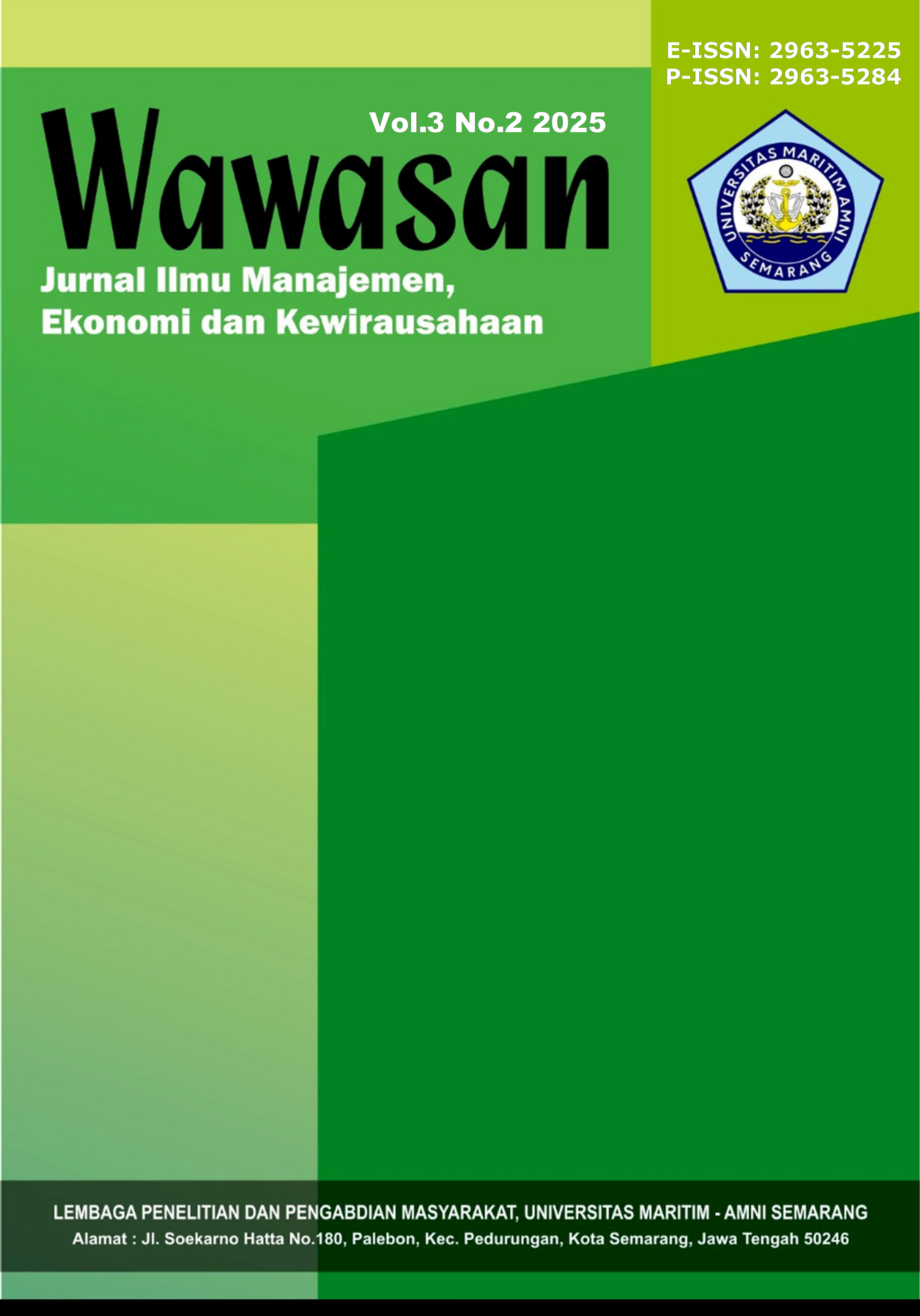Pengaruh Leverage, Likuiditas, dan Pertumbuhan Penjualan Terhadap Financial Distress Perusahaan Subsektor Aneka Industri Periode 2020-2023
DOI:
https://doi.org/10.58192/wawasan.v3i2.3165Keywords:
Financial Distress, Leverage, Liquidity, Sales Growth, Firm SizeAbstract
This study analyzes the effect of Leverage (Debt to Asset Ratio/DAR), Liquidity (Current Ratio/CR), and Sales Growth on Financial Distress, with Firm Size as a control variable. Financial distress is proxied by a Negative Net Income within one year. The object of this study is manufacturing companies in the miscellaneous industry subsector listed on the Indonesia Stock Exchange (IDX) for the 2020-2023 period. The sample consists of 42 companies, with a total of 168 observations, selected using the purposive sampling method. The data used is secondary data from company financial statements, analyzed using panel data regression with the EViews application, and tested using logistic regression. The results show that Leverage (DAR) has no significant effect on Financial Distress, while Liquidity (CR) and Sales Growth have a negative and significant effect on Financial Distress. Additionally, the control variable, Firm Size, also shows a negative effect on Financial Distress. This study is expected to serve as a consideration for company management in managing debt and formulating sales growth strategies to minimize the risk of financial distress. For investors and creditors, the findings of this study can be used as a reference in evaluating a company's financial condition before making funding and investment decisions.
References
Ahmad, E. F., & Hanifan, T. M. (2022). Pengaruh laba dan arus kas terhadap financial distress. Jurnal Akuntansi dan Sistem Informasi, 3(2), 253–262.
Antoniawati, A., & Purwohandoko, P. (2022). Analisis pengaruh profitabilitas, likuiditas, dan leverage terhadap financial distress pada perusahaan transportasi yang terdaftar di BEI tahun 2018-2020. Jurnal Ilmu Manajemen V, 10(1), 28–38.
Ardiansyah, A., & Wahidahwati. (2020). Analisis pengaruh likuiditas, leverage, arus kas, dan kepemilikan institusional terhadap financial distress. Jurnal Ilmu dan Riset Akuntansi, 9(8), 1–18.
Arif Efendi, F., Fernanda, D., & Thahirah, K. A. (2023). Analisis pengaruh profitabilitas, leverage, dan ukuran perusahaan terhadap financial distress. Jurnal Akuntansi Keuangan dan Bisnis, 1(2), 97–100. https://jurnal.ittc.web.id/index.php/jakbs/index
Asmiraldha, I. N., Novietta, L., Nurmadi, R., & Naskah, H. (2024). Leverage dan aktivitas terhadap financial distress dengan profitabilitas sebagai variabel moderasi pada perusahaan subsektor food & beverage yang terdaftar di BEI periode. JEBMA: Jurnal Ekonomi Bisnis, Manajemen dan Akuntansi, 4(3), 1623–1637.
Badan Pusat Statistik. (2020). Analisis hasil survei dampak COVID-19 terhadap pelaku usaha.
Badan Pusat Statistik. (2022). Inflasi year-on-year (Y-on-Y) pada Desember 2022.
Badan Pusat Statistik. (2023). Ekonomi Indonesia triwulan IV-2023 tumbuh 5,04 persen (Y-on-Y).
Damayanti, D. P., & Widati, L. W. (2024). Faktor-faktor yang mempengaruhi financial distress (Studi kasus pada perusahaan manufaktur sektor industri barang konsumsi yang terdaftar di Bursa Efek Indonesia tahun 2020-2022). Jurnal Ilmiah Komputerisasi Akuntansi, 17(1), 104–116.
Fitriana, A. (2024). Analisis laporan keuangan. CV Malik Rizki Amanah.
Hadi, A. (2022). Pengaruh rasio-rasio keuangan terhadap financial distress pada perusahaan sektor perdagangan, jasa, dan investasi. JIM: Jurnal Ilmu Manajemen, 10(1), 1–10.
Hayati, L. M., & Sholichah, M. (2022). Peran profitabilitas dalam memoderasi pengaruh rasio likuiditas, leverage, dan sales growth dalam memprediksi financial distress pada perusahaan subsektor properti dan real estate. Journal of Culture Accounting and Auditing, 1(1), 153–167. http://journal.umg.ac.id/index.php/jcaa
Hidayat, T., Yahya, A., Heruwanto, J., & Wibowo, R. (2024). Peran leverage sebagai moderasi pengaruh profitabilitas dan likuiditas terhadap financial distress. EKOMABIS: Jurnal Ekonomi Manajemen Bisnis, 5(2), 237–250. https://doi.org/10.37366/ekomabis.v5i02.1582
Hutabarat, M. I. (2022). Pengaruh ROA, pertumbuhan penjualan, likuiditas, dan ukuran perusahaan terhadap struktur modal perusahaan manufaktur sektor makanan dan minuman di BEI. Owner: Riset & Jurnal Akuntansi, 6(1), 348–358. https://doi.org/10.33395/owner.v6i1.589
International Monetary Fund (IMF). (2023). World economic outlook 2023: Navigating global divergences.
Lifia, S., Gurendrawati, E., & Fauzi, A. (2020). Pengaruh solvabilitas, pertumbuhan penjualan, dan biaya agensi manajerial terhadap financial distress: Studi empiris pada perusahaan sektor properti dan real estate yang terdaftar di Bursa Efek Indonesia periode 2016-2018. Jurnal Akuntansi, Perpajakan, dan Auditing, 1(2), 179–194.
Maryanti, L., & Susilo, A. Z. (2021). Pengaruh profitabilitas, sales growth, likuiditas, dan leverage terhadap financial distress. Profita: Kajian Ilmu Akuntansi, 9(5), 54–70.
Muslimin, D. W., & Bahri, S. (2023). Pengaruh GCG, ukuran perusahaan, dan sales growth terhadap financial distress. Owner: Riset & Jurnal Akuntansi, 7(1), 293–301. https://doi.org/10.33395/owner.v7i1.1249
Muzharoatiningsih, M., & Hartono, U. (2022). Pengaruh rasio keuangan, sales growth, dan ukuran perusahaan terhadap financial distress pada sektor industri barang konsumsi di BEI periode 2017-2020. Jurnal Ilmu Manajemen, 10(3), 747–758.
Nadapdap, L. A., & Shadrina Hazmi, S. (2024). The effect of liquidity, sales growth and firm size on financial distress in manufacturing companies in various industrial sectors listed on the Indonesian Stock Exchange for the 2020 - 2022 period. Jurnal Akuntansi, Manajemen, dan Perencanaan Kebijakan, 2(1), 1–14. https://doi.org/10.47134/jampk.v2i1.421
Pakaya, A., Lamuda, I., & Rahman, Z. (2023). Analisis rasio leverage untuk menilai kinerja keuangan perusahaan dagang. JEMAI: Jurnal Ekonomi Manajemen dan Akuntansi, 2(2), 52–59. https://jurnal.unigo.ac.id/index.php/jemai
Panigoro, N., Dewi Nainggolan, C., Hartono, A., & Alamsyahbana, M. I. (2023). The influence of good corporate governance and sales growth against financial distress. Aksara: Jurnal Ilmu Pendidikan Nonformal, 9(3), 1859–1870. https://doi.org/10.37905/aksara.9.3.1859-1870.2023
Purwaningsih, E., & Safitri, I. (2022). Pengaruh profitabilitas, likuiditas, leverage, rasio arus kas, dan ukuran perusahaan terhadap financial distress. JAE: Jurnal Akuntansi dan Ekonomi, 7(2), 147–156. https://doi.org/10.29407/jae.v7i2.17707
Qotimah, K., Kalangi, L., & Korompis, C. W. M. (2023). Pengaruh analisa fundamental terhadap return investasi pada saham second liner di sektor energi periode 2019-2022 yang terdaftar di Bursa Efek Indonesia. Jurnal EMBA: Jurnal Riset Ekonomi, Manajemen, Bisnis, dan Akuntansi, 11(3), 12–26.
Rahma, A. (2020). Analisis pengaruh profitabilitas, leverage, dan likuiditas terhadap financial distress. Jurnal Akuntansi Berkelanjutan Indonesia, 3(3), 253–266. http://openjournal.unpam.ac.id/index.php/jabi
Rejeki, W. N., Hidayati, S. A., & Tara, N. A. A. (2023). Kepemilikan institusional, likuiditas, leverage, dan financial distress: Investigasi efek moderasi profitabilitas. Journal of Economics and Business UBS, 12(3), 1929–1950.







